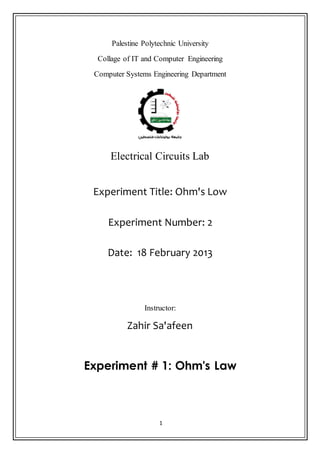
Lab 2
- 1. 1 Palestine Polytechnic University Collage of IT and Computer Engineering Computer Systems Engineering Department Electrical Circuits Lab Experiment Title: Ohm's Low Experiment Number: 2 Date: 18 February 2013 Instructor: Zahir Sa'afeen Experiment # 1: Ohm's Law
- 2. 2 Objectives: To study the dependence of current (I) on the potential difference (V) across a resistor and determine its resistance using Ohm's low. Also plot a graph between V and I. Additionally to know how to find the resistance by different ways: color code, DMM, and Ohm's low. Equipments: 1. DMM(Digital Multimeter). 2. Ammeter. 3. Wires. 4. Power Supply. 5. DC Fundamental circuit board. 6. FACET base unit. Theory: Ohm's Law states that the direct current flowing in a conductoris directly proportional to the potential difference between its ends. It is usually formulated as V = IR, where V is the potential difference, or voltage, I is the current, and R is the resistance of the conductor;which its value can be measured by ohm's low, color codeor DMM. Current, voltage and resistance have a linear relation. In any circuit I is directly proportional with voltage and inversely proportional with resistance.
- 3. 3 Calculations and Analysis: VA = 2 I = 1.33 R = V/R = 2 / 1.33 = 1.5 Slope = ∆ V/ ∆ I = (4 – 2) / (2.67 – 1.33) = 2 / 1.34 = 1.49 Slope = R 0 2 4 6 8 10 12 0 2 4 6 8 voltage(V) Current(A) RealationShip Between V & I
- 4. 4 Experimental circuits and exercises: Exercise 1 : ( Ohm's Law - Circuit Resistance )
- 5. 5 Exercise 2 : ( Ohm's Law - Circuit Current )
- 6. 6 Exercise 3:( Ohm's Law - Circuit Voltage ) Conclusions: Ohm’s law states that voltage is directly proportional to current, provided that the temperature remains constant. We can use Ohm's low to determine the resistance (R=V/I) and verify that by using ohmmeter or color code. We can use Ohm's low to determine the current value(I=V/R) and verify that by using Ammeter which is connected in series to the circuit. Also we can use Ohm's low to determine the voltage value(V=IR) and verify that by using Voltmeter which is connected in parallel to the circuit.